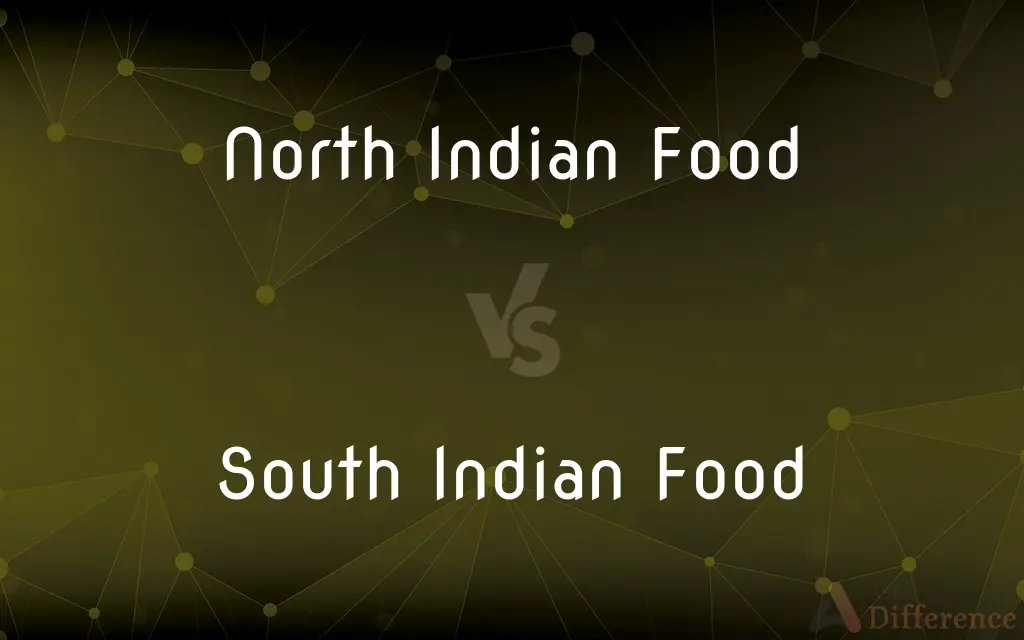North Indian Food vs. South Indian Food — What's the Difference?
By Tayyaba Rehman & Fiza Rafique — Published on September 5, 2024
North Indian food is characterized by its heavy use of dairy and wheat-based dishes, while South Indian cuisine is known for its rice-based meals and prominence of lentils and spices.

Difference Between North Indian Food and South Indian Food
Table of Contents
ADVERTISEMENT
Key Differences
North Indian food often features a rich and hearty texture with a significant use of dairy products like milk, paneer (cottage cheese), and ghee (clarified butter). Whereas, South Indian cuisine is marked by a lighter, often spicier fare that incorporates coconut and tamarind, giving it a distinct tangy and savory flavor.
North Indian meals predominantly include breads like rotis, naans, and parathas made from wheat. On the other hand, South Indian food is famous for its rice-based dishes such as idli, dosa, and rice served with sambar and rasam.
The cooking techniques in North Indian cuisine usually involve baking, sautéing, and grilling, leading to dishes like kebabs and tandoori items. Meanwhile, South Indian cooking techniques often include steaming (as seen in idlis) and tempering, a method that enhances the flavor of a dish with spices heated in hot oil.
North Indian cuisine is well-known for its Mughlai and Punjabi dishes, which include a variety of rich curries and gravies. Whereas South Indian cuisine offers a vast array of vegetarian options, emphasizing the use of lentils and vegetables in dishes like sambar, a lentil-based stew.
The use of spices in North Indian food tends to be subtle and integrated into creamy gravies, while South Indian cuisine uses spices more liberally and distinctly, often showcasing the individual flavors of mustard seeds, curry leaves, and black pepper.
ADVERTISEMENT
Comparison Chart
Base Ingredients
Wheat, dairy
Rice, coconut, tamarind
Typical Dishes
Roti, naan, paneer dishes
Idli, dosa, sambar
Spices and Flavors
Subtle, creamy gravies
Bold, tangy, and spicy
Cooking Techniques
Baking, sautéing, grilling
Steaming, tempering
Predominant Meal Types
Hearty and rich
Lighter and spicier
Compare with Definitions
North Indian Food
A fresh cheese common in North Indian dishes, used in curries and snacks.
Paneer tikka is a vegetarian North Indian delicacy made by marinating paneer in spices and grilling it.
South Indian Food
A fermented crepe made from rice batter and black lentils, a South Indian specialty.
Dosas can be plain or filled with spicy potato filling, making them a favorite South Indian snack or meal.
North Indian Food
A method of cooking over a charcoal fire in a clay oven, prevalent in North India.
Tandoori chicken, marinated in yogurt and spices, is a favorite North Indian appetizer.
South Indian Food
A cuisine featuring rice, lentils, and a distinct use of spices and coconut.
Masala dosa is a South Indian staple, consisting of a crispy rice pancake filled with spiced potatoes.
North Indian Food
A wheat-based flatbread staple in North Indian meals.
Rotis are often served with dal or curry in North Indian cuisine.
South Indian Food
A tangy lentil stew with vegetables and spices, essential to South Indian meals.
Sambar is a versatile dish in South Indian cuisine, enjoyed with rice, idlis, or dosas.
North Indian Food
Rich, creamy dishes with Persian influence, characteristic of North India.
Biryani, a fragrant rice dish with meat or vegetables, is a celebrated Mughlai dish in North India.
South Indian Food
A spicy and sour soup made from tamarind juice and spices in South India.
Rasam is often consumed as a digestive or with rice as part of a South Indian meal.
North Indian Food
A cuisine rich in dairy and spices, known for its bread and curry dishes.
Butter chicken is a popular North Indian dish known for its creamy tomato gravy.
South Indian Food
A steamed rice cake, popular in South Indian breakfasts.
Idlis are typically served with sambar and coconut chutney in South Indian homes.
Common Curiosities
Can you name a popular North Indian snack?
Samosas are a popular snack, filled with spiced potatoes and peas.
What are the main ingredients in North Indian food?
North Indian cuisine primarily uses wheat and dairy products.
What is a common breakfast in South India?
Common breakfasts include idli, dosa, and upma.
How does the use of spices differ between the two cuisines?
North Indian spices are often blended into gravies, while South Indian spices are more likely to be used whole or tempered.
Are there any common ingredients between North and South Indian foods?
Common ingredients include rice, lentils, and certain spices, although their preparation differs.
What rice dish is typical for South Indian cuisine?
Lemon rice and tamarind rice are popular rice dishes.
What is a distinctive feature of South Indian cooking techniques?
Steaming and tempering are distinctive South Indian cooking techniques.
Is vegetarian food more prevalent in one cuisine over the other?
Both cuisines offer a variety of vegetarian dishes, but South Indian cuisine is particularly noted for its vegetarian fare.
How is dairy used in North Indian cuisine?
Dairy products like paneer, ghee, and yogurt are extensively used in North Indian dishes.
What is a typical South Indian dinner?
A typical dinner might include rice with sambar, rasam, and various vegetable dishes.
What kind of breads are common in North Indian food?
Breads like roti, naan, and paratha are staples.
What makes South Indian food spicy?
The liberal use of chili peppers, black pepper, and other spices makes it spicy.
What is a key difference in breakfast dishes between the two regions?
North Indian breakfasts may include parathas and puris, while South Indian breakfasts feature idlis and dosas.
How does the climate influence the cuisine of each region?
The warmer, tropical climate of the South influences its lighter, rice-based meals, while the cooler North supports wheat cultivation and dairy farming, influencing its cuisine.
What is a famous dessert in North Indian cuisine?
Gulab jamun, sweet milk-solid balls soaked in sugar syrup, is a famous dessert.
Share Your Discovery

Previous Comparison
Hamburger vs. Cheese Burger
Next Comparison
Binary Acid vs. Ternary AcidAuthor Spotlight
Written by
Tayyaba RehmanTayyaba Rehman is a distinguished writer, currently serving as a primary contributor to askdifference.com. As a researcher in semantics and etymology, Tayyaba's passion for the complexity of languages and their distinctions has found a perfect home on the platform. Tayyaba delves into the intricacies of language, distinguishing between commonly confused words and phrases, thereby providing clarity for readers worldwide.
Co-written by
Fiza RafiqueFiza Rafique is a skilled content writer at AskDifference.com, where she meticulously refines and enhances written pieces. Drawing from her vast editorial expertise, Fiza ensures clarity, accuracy, and precision in every article. Passionate about language, she continually seeks to elevate the quality of content for readers worldwide.













































